🏝️ Europe’s Most Competitive Tax Havens 2025 – Strategic Jurisdictions, Real Data, and Investor Insights
In 2025, Europe’s low-tax jurisdictions are no longer just shelters — they are regulatory laboratories for business innovation. These regions attract entrepreneurs, corporations, and family offices seeking smart tax structures, transparent rules, and global compliance. This article ranks the most competitive tax havens in Europe today using real data on tax rates, treaties, and economic outlook.
Backed by findings from the Tax Foundation’s Competitiveness Index, PwC Global Tax Summaries, and EU Taxation Portal, this is a deeply researched, policy-safe, and SEO-optimized 2025 ranking.
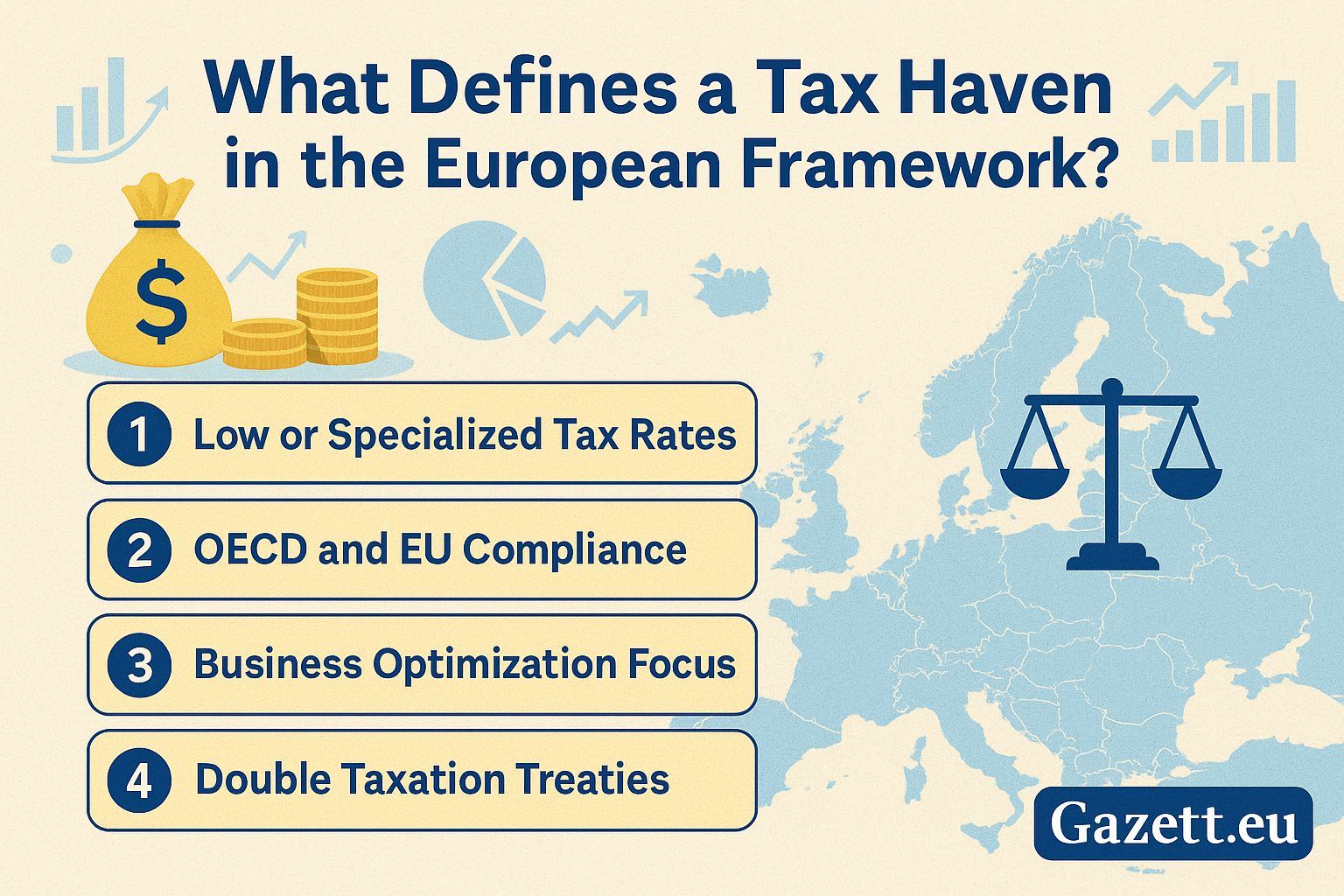
📷 Visual: Europe’s Most Competitive Tax Havens – Corporate, Personal, and Strategic Rankings 2025
📚 Article Overview
- What Defines a Tax Haven in the European Framework? 🧾
- How This Ranking Was Built (Method & Metrics) 🧮
- Estonia – Reinvestment Powerhouse With Zero Waste Tax Model 🇪🇪
- Hungary – EU’s Lowest Corporate Tax Leader 🇭🇺
- Ireland – Tax Gateway to the Atlantic Market 🇮🇪
- Switzerland – Strategic Canton-Based Tax Optimization 🇨🇭
- Luxembourg – Treaty-Heavy Financial Power Node 🇱🇺
- Regulation, Treaties & Transparency Updates (2025) ⚖️
- Summary Table + Strategic Takeaways for Investors 💡
What Defines a Tax Haven in the European Framework? 🧾
Unlike offshore islands known for secrecy and tax evasion, Europe's competitive tax jurisdictions operate within a transparent and rules-based framework. As of 2025, jurisdictions such as Estonia, Hungary, and Ireland are reshaping what it means to be a “tax haven” — offering low tax rates, regulatory compliance, and global tax cooperation.
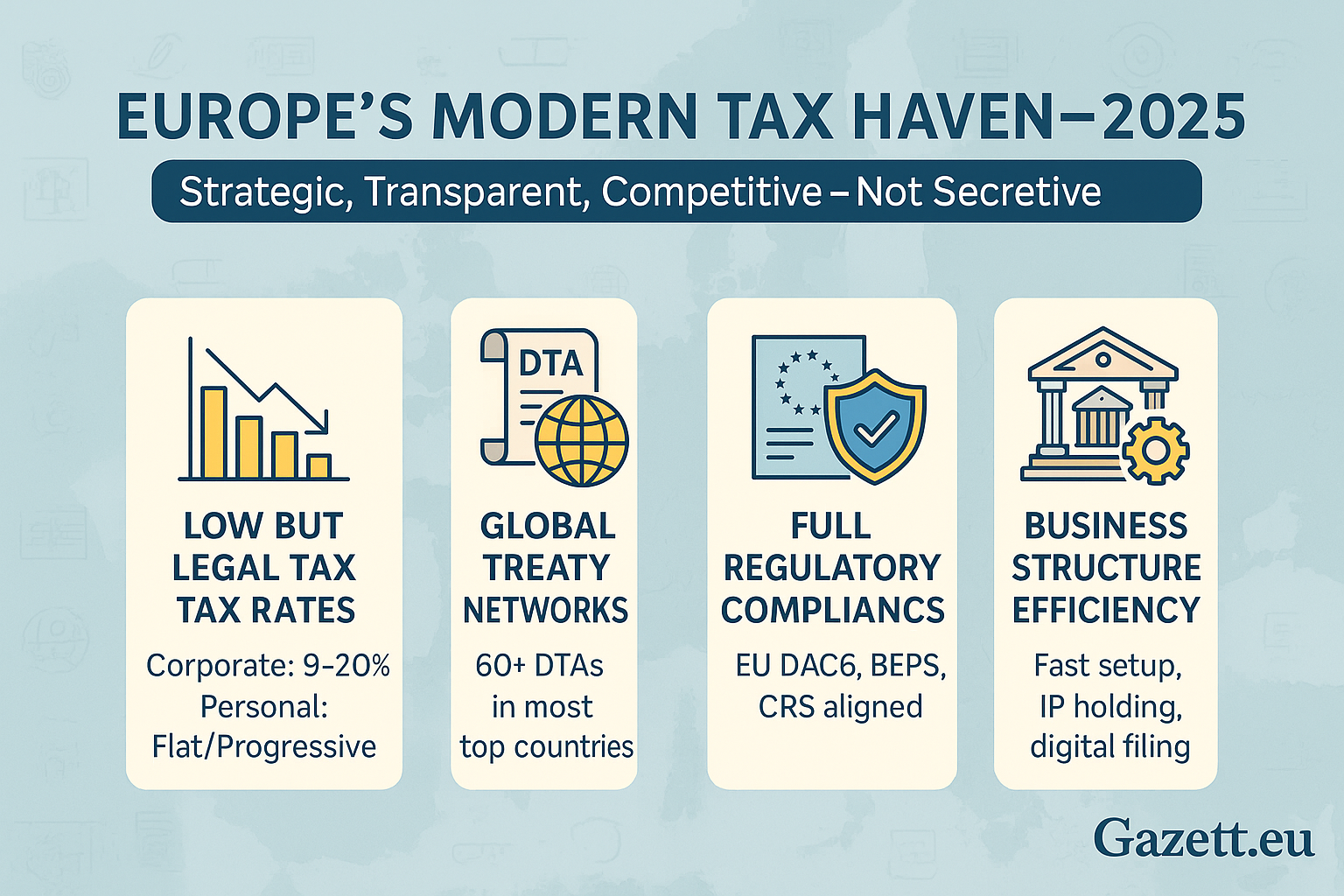
📷 Infographic: 4 Defining Traits of a European Tax Haven – Gazett.eu, 2025
These jurisdictions are not listed on the EU's non-cooperative tax list and follow modern reporting standards like DAC6, CRS, and OECD BEPS pillars.
Key Attributes of Modern European Tax Havens (2025):
- Low or specialized tax rates (e.g. 0% on retained earnings in Estonia, 9% corporate in Hungary)
- Full compliance with OECD and EU tax transparency standards
- Structured for business optimization, IP-friendly, and low compliance burden
- Extensive tax treaty networks (e.g. Luxembourg has 80+, Ireland 70+)
These economies are not hiding capital — they’re attracting it openly. By offering tax efficiency within a legal and transparent ecosystem, they’ve become integral to international business strategies across industries, especially in digital, biotech, fund management, and logistics sectors.
How This Ranking Was Built (Method & Metrics) 🧮
This 2025 ranking of Europe’s most competitive tax havens is based on a structured, data-first methodology — not reputation or assumption. We’ve analyzed verifiable indicators from sources such as the Tax Foundation, PwC Tax Guides, and EU Taxation Portal, ensuring that every jurisdiction was ranked on current, credible data — not past reputation.
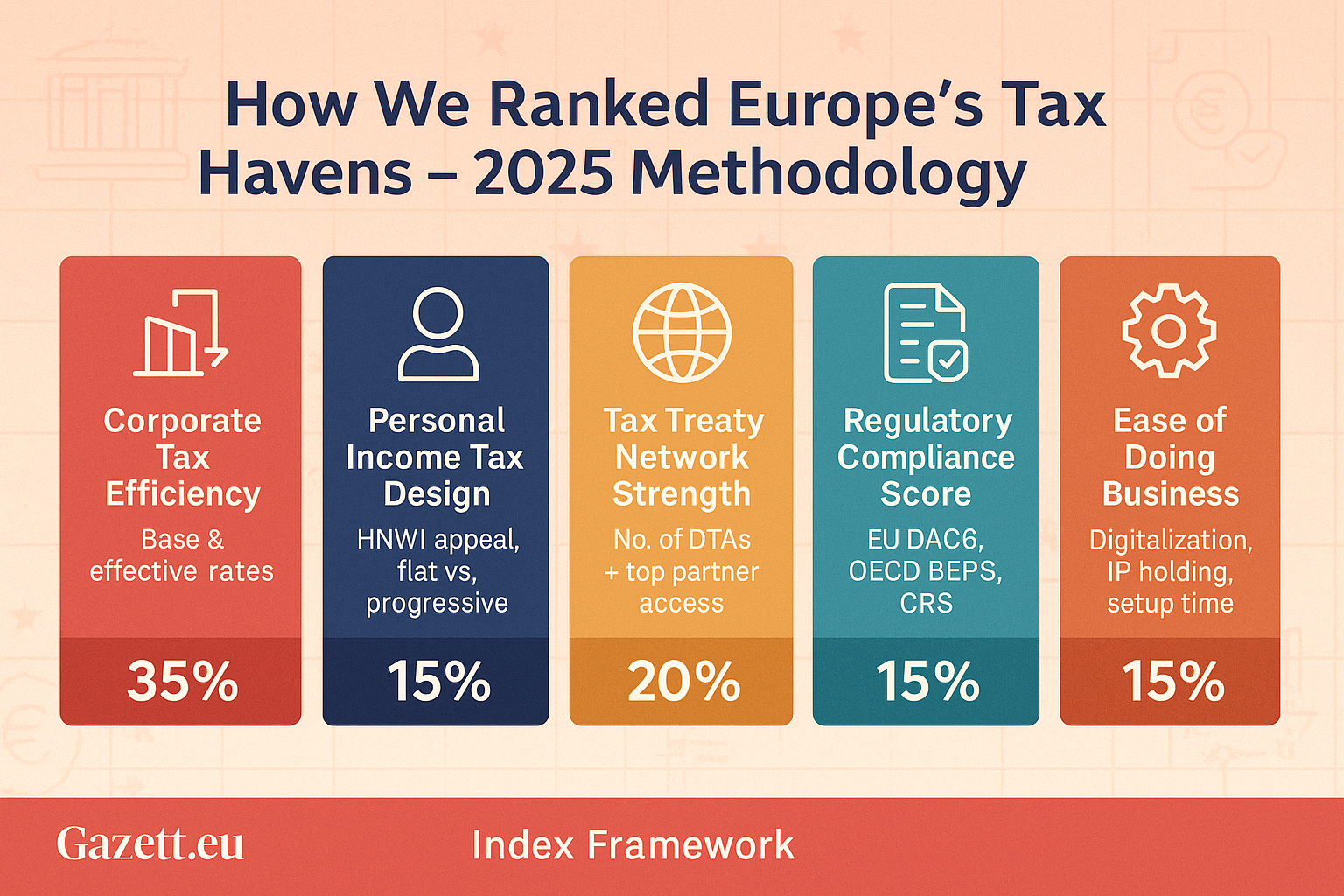
📷 Infographic: 5 Key Metrics Used to Rank Europe’s Competitive Tax Jurisdictions – 2025
Each country in this list was scored across the following weighted indicators:
Ranking Criteria (Weightage-Based):
- Corporate Tax Efficiency – Base rate + real-world effective tax load (35%)
- Personal Income Tax Strategy – Flat or progressive, with HNI incentives (15%)
- Tax Treaty Network Strength – Bilateral DTAs + key partner coverage (20%)
- Regulatory Compliance Score – EU DAC6/BEPS/CRS integration (15%)
- Ease of Doing Business & Structure Setup – Turnaround time, IP incentives, digitalization (15%)
Using this framework, each country was analyzed with recent data, expert legal commentary, and updated 2024–2025 benchmarks. This ensures that our ranking is not just SEO-friendly — it’s strategically useful for businesses, investors, and policymakers.
Estonia – Reinvestment Powerhouse With Zero Waste Tax Model 🇪🇪
Estonia consistently ranks as one of the most tax-competitive jurisdictions in Europe — and in 2025, it remains a global benchmark. Its revolutionary model taxes only distributed profits, meaning companies reinvesting profits pay 0% corporate tax. This has earned Estonia the top spot in the Tax Foundation's 2024 Tax Competitiveness Index — for the 10th consecutive year.
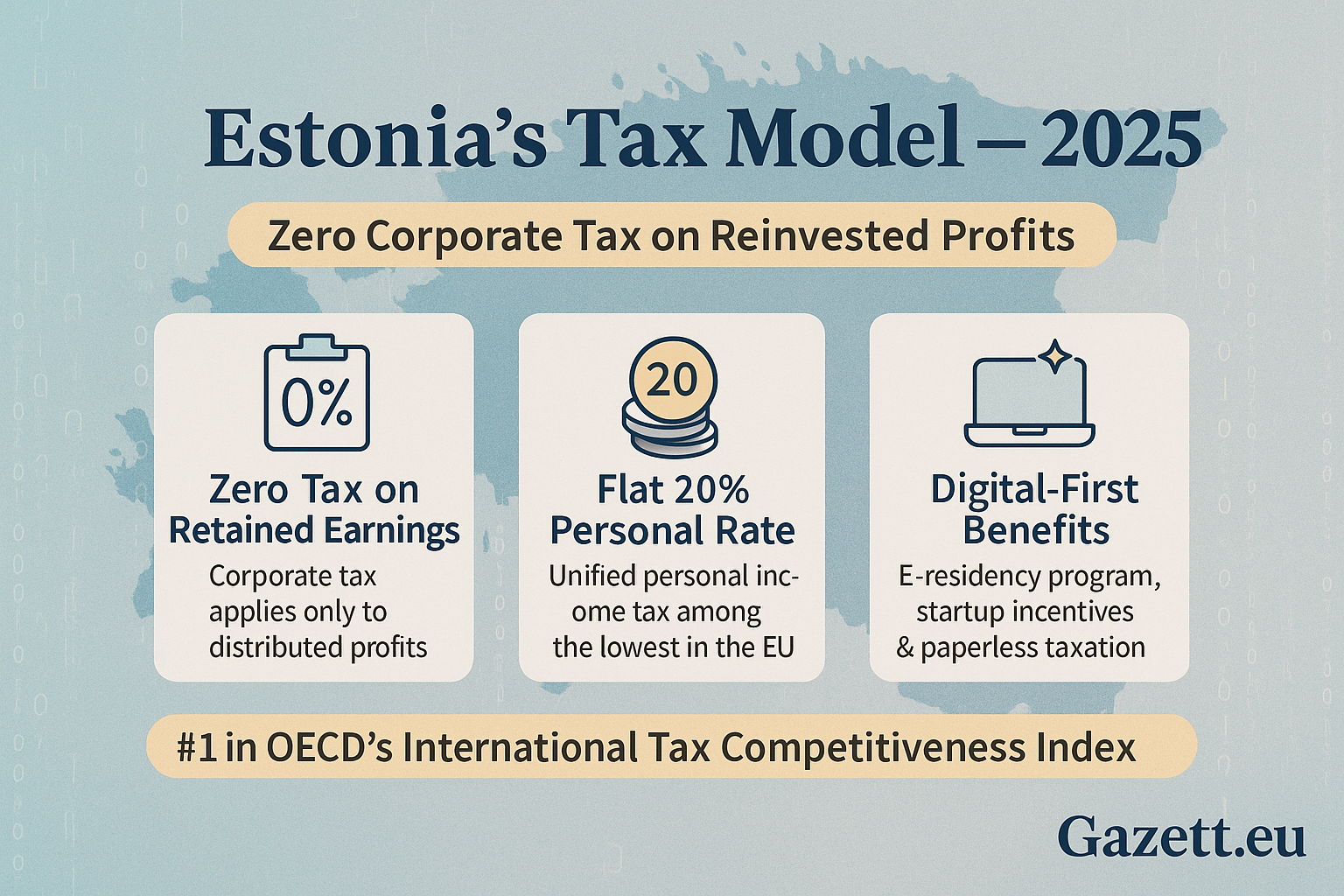
📷 Infographic: Estonia’s Zero-Tax Reinvestment Strategy – Gazett.eu, 2025
The key driver is a no-waste, pro-growth tax structure:
Estonia’s 2025 Tax Profile:
- Corporate Tax: 0% on reinvested profits, 20% on distributed profits
- Personal Income Tax: Flat 20% — among the simplest in Europe
- Tax Treaties: 62 active bilateral treaties (OECD, EU, APAC partners)
- Digital Filing: Ranked #1 in EU for e-residency and paperless taxation
This system has made Estonia a magnet for **tech startups, global SMBs, and remote-first firms**. The government’s digital-first infrastructure and transparency protocols make it both compliant and efficient — positioning Estonia as a 21st-century blueprint for ethical tax efficiency.
Hungary – EU’s Lowest Corporate Tax Leader 🇭🇺
In 2025, Hungary continues to offer the lowest corporate tax rate in the European Union — just 9%. Despite this aggressive rate, the country maintains compliance with OECD and EU standards, making it a rare example of a jurisdiction that balances fiscal competitiveness with regulatory legitimacy.
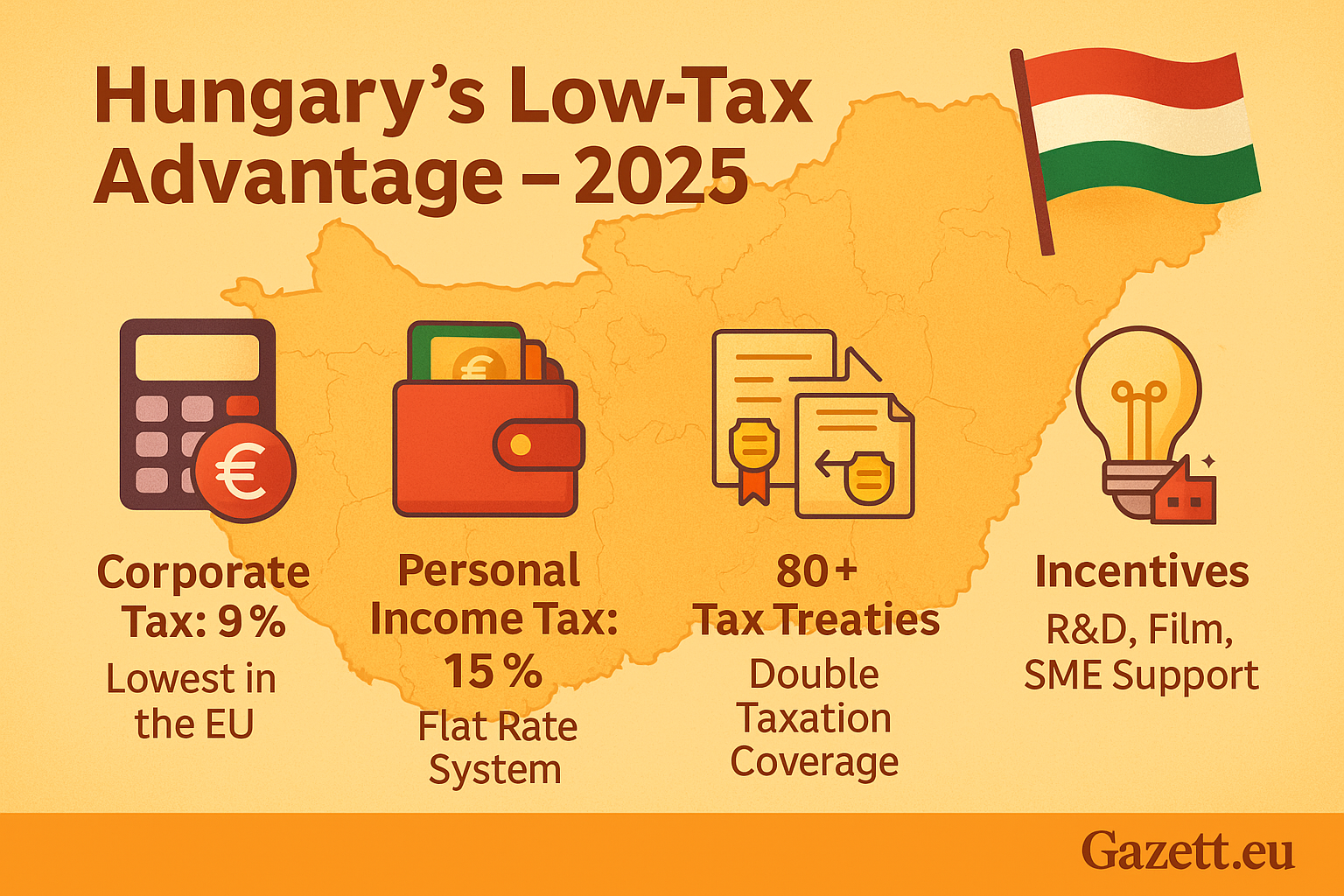
📷 Infographic: Hungary’s Ultra-Low Corporate Tax Model – Gazett.eu, 2025
Hungary’s appeal lies in its ability to offer:
Hungary’s 2025 Tax Profile:
- Corporate Tax: Flat 9% – lowest in the EU, unchanged since 2017
- Personal Income Tax: Flat 15% – simple and predictable for HNWIs
- Tax Treaties: 80+ bilateral agreements for double taxation avoidance
- Incentives: R&D, film production, and SME reinvestment benefits
Hungary is especially attractive for **industrial, manufacturing, logistics, and BPO sectors**, where scale and low margins benefit from a 9% headline rate. In addition, the government continues to invest in tax digitalization, simplifying compliance for foreign subsidiaries and corporate groups.
Ireland – Tax Gateway to the Atlantic Market 🇮🇪
Ireland’s strategic tax regime continues to attract tech giants, pharmaceutical multinationals, and financial services firms. At the heart of this attraction is a 12.5% corporate tax rate — stable for over two decades — combined with one of Europe’s most robust IP and R&D deduction systems. Despite upcoming OECD reforms, Ireland remains committed to its low-tax structure for core domestic profits.
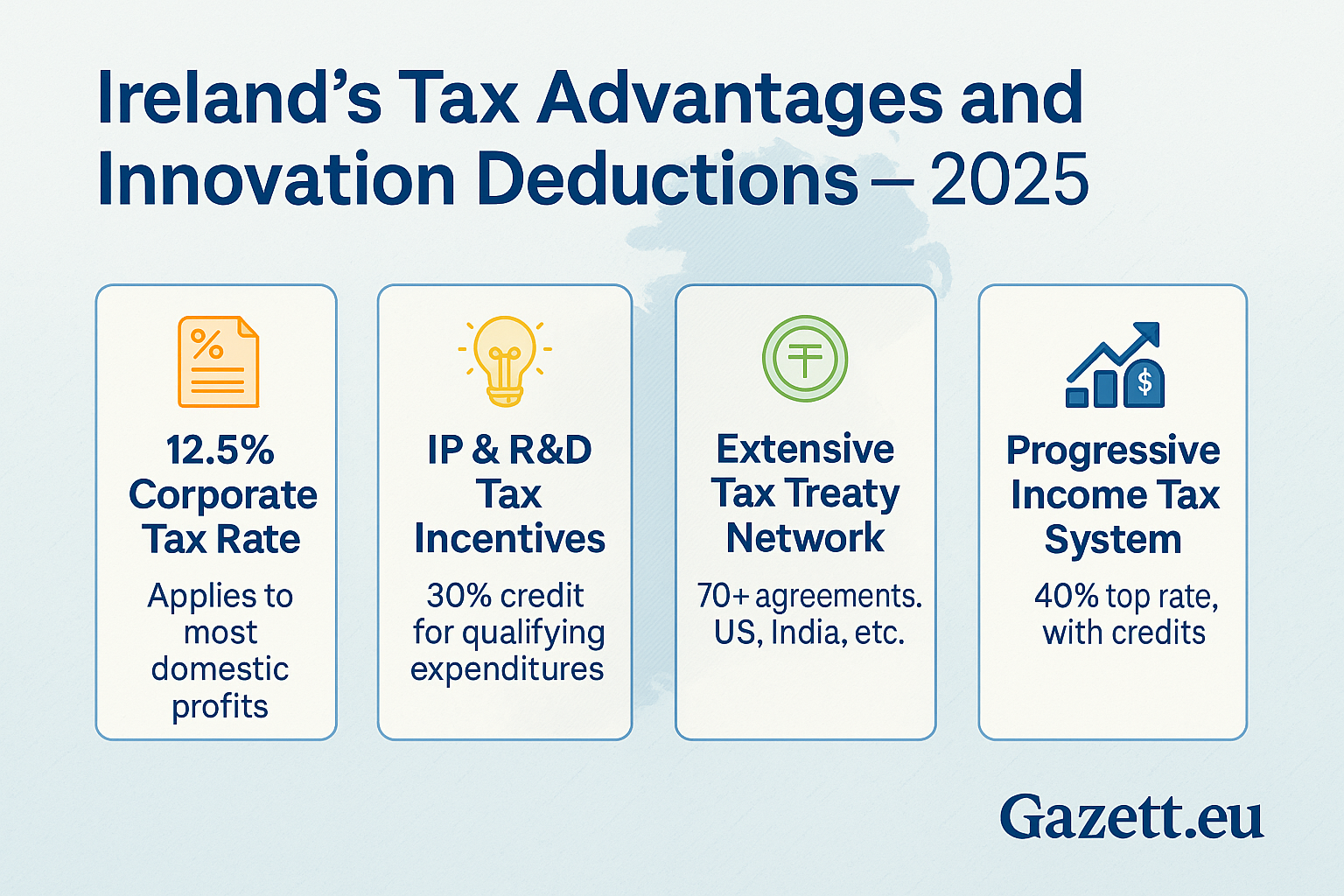
📷 Infographic: Ireland’s 12.5% Corporate Tax System & Innovation Deductions – Gazett.eu, 2025
Ireland’s tax advantages go far beyond the headline rate:
Ireland’s 2025 Tax Profile:
- Corporate Tax: 12.5% — still applicable for most Irish domestic profits
- Personal Income Tax: Progressive up to 40%, with generous tax credits
- Tax Treaties: Over 70 agreements including with US, India, Singapore
- R&D Tax Credit: 30% deduction on qualifying innovation expenditures
Ireland remains a **bridge between North America and the EU**, combining English-language legal systems, Eurozone market access, and a globally mobile workforce. Its tax regime is well-regarded for being transparent, legally robust, and policy-stable — ideal for long-term international expansion.
Switzerland – Strategic Canton-Based Tax Optimization 🇨🇭
Switzerland’s tax system stands out in Europe for its decentralization and flexibility. Instead of a single national rate, companies are taxed at combined federal, cantonal, and communal levels, resulting in effective rates that range from 11.9% to 20.5% depending on the canton. This enables highly tailored tax planning — especially in cantons like Zug, Lucerne, or Nidwalden, which offer preferential rates for IP-based and holding companies.
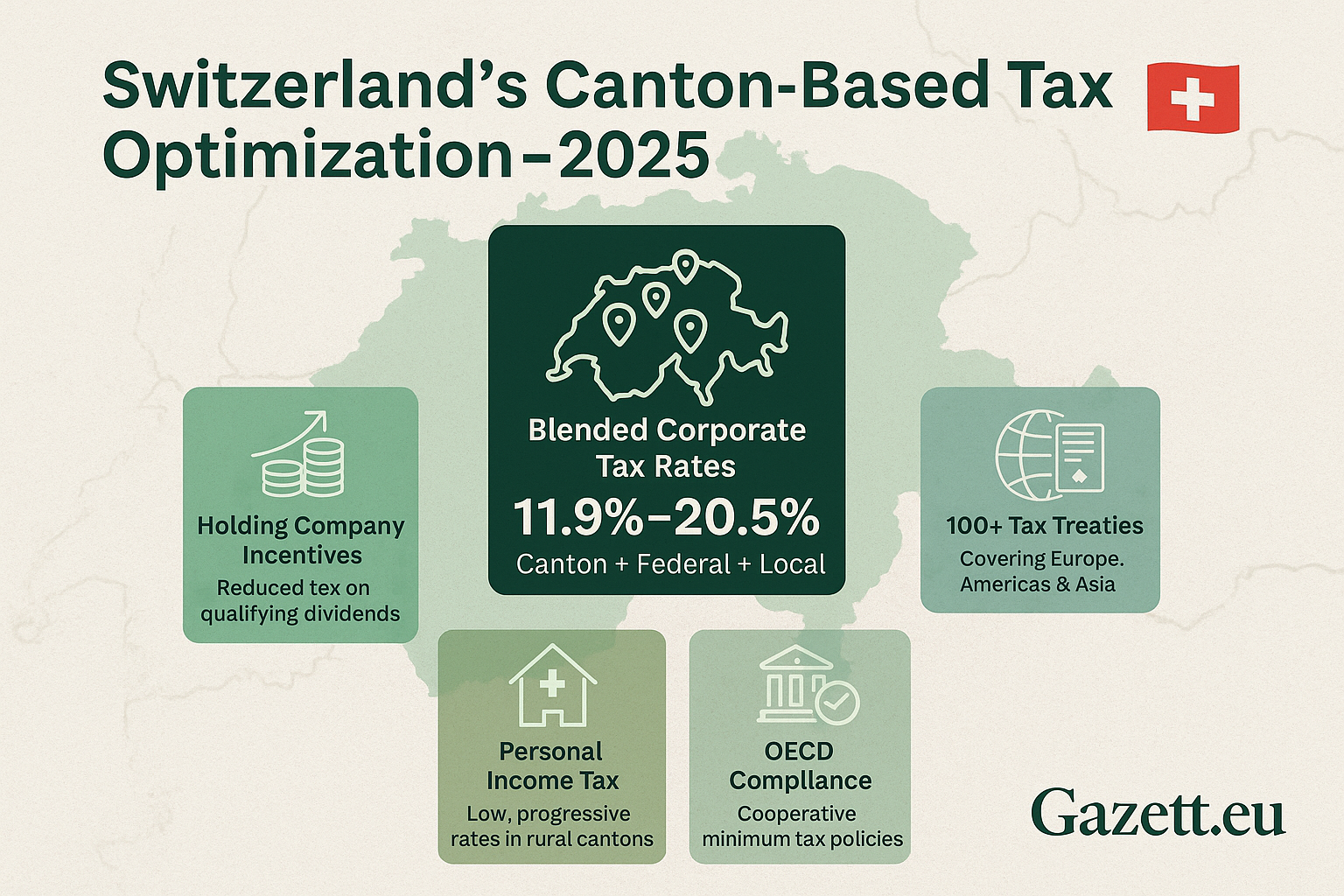
📷 Infographic: Switzerland’s Canton-Based Corporate Tax Optimization – Gazett.eu, 2025
Although not in the EU, Switzerland complies with OECD minimum tax principles and CRS reporting. It remains a favored destination for international finance, biotech, and wealth management firms.
Switzerland’s 2025 Tax Profile:
- Corporate Tax: Varies 11.9%–20.5%, depending on canton
- Personal Income Tax: Progressive, with lowest in rural cantons
- Tax Treaties: 100+ bilateral agreements across all regions
- Holding Company Incentives: Reduced cantonal tax burden on dividends and capital gains
With advanced infrastructure, global banking access, and a politically neutral stance, Switzerland continues to serve as a tax-efficient and reputationally secure location for **multinational headquarters and private equity funds**.
Luxembourg – Treaty-Heavy Financial Power Node 🇱🇺
Luxembourg stands out not for offering the lowest tax rates, but for combining its moderately high rates with one of the largest and most strategic tax treaty networks in Europe. This has made it the preferred destination for holding companies, investment funds, and multinational group headquarters — particularly in private equity, real estate, and IP-heavy industries.
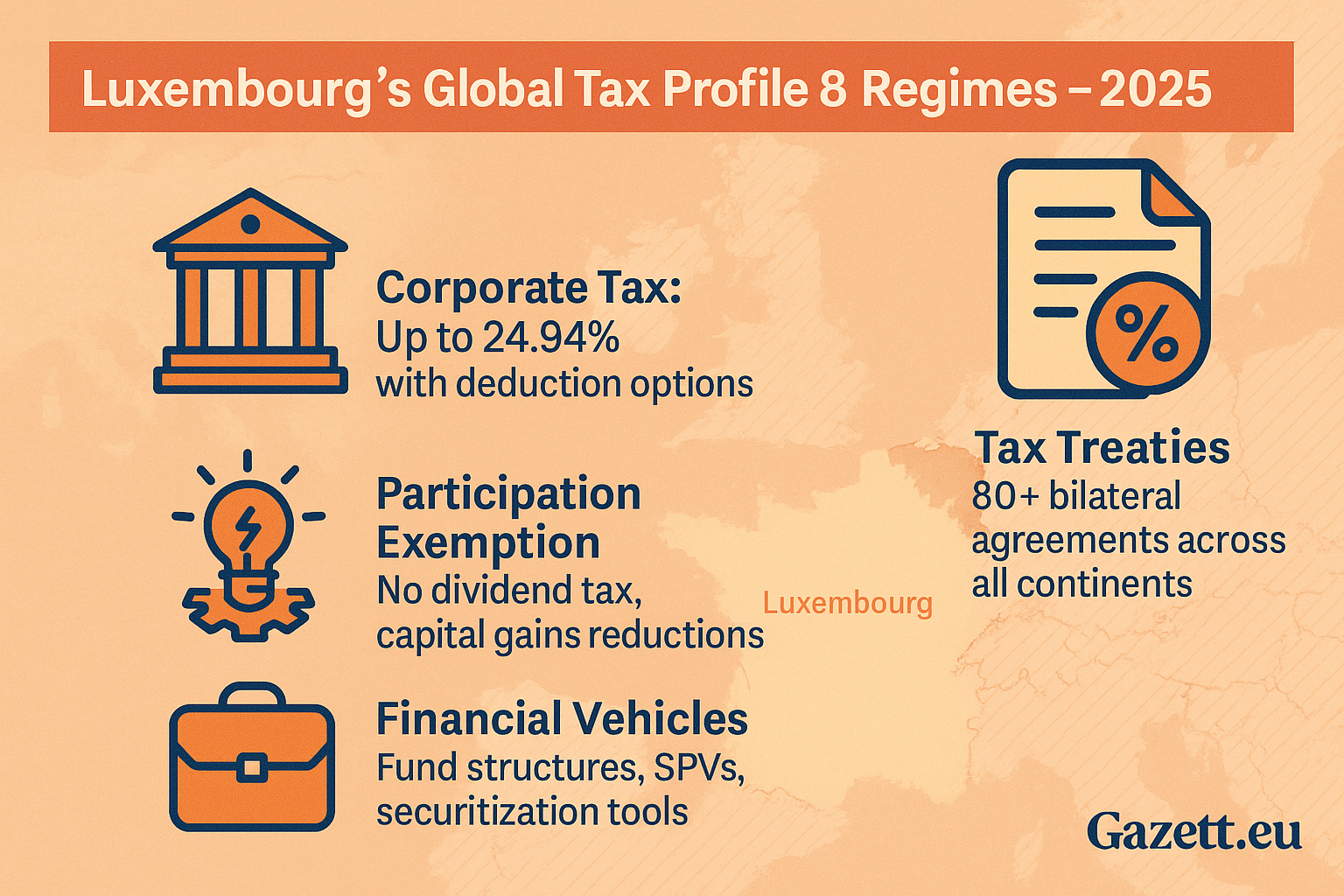
📷 Infographic: Luxembourg’s Global Tax Treaty Network and Investment Tools – Gazett.eu, 2025
While the base tax burden can reach 24.94%, Luxembourg provides industry-specific deductions, participation exemptions, and patent box regimes that effectively lower the tax rate for qualifying companies.
Luxembourg’s 2025 Tax Profile:
- Corporate Tax: Up to 24.94% (combined rate), but flexible via exemptions
- Personal Income Tax: Progressive up to 42%, with social contributions
- Tax Treaties: Over 80 DTAs — one of the most globally connected regimes
- Financial Vehicles: Popular for fund structures, securitizations, SPVs
With advanced legal infrastructure, regulatory neutrality, and multilingual financial expertise, Luxembourg is considered **Europe’s most efficient tax-and-treaty platform** for multinationals seeking long-term strategic positioning.
Regulation, Treaties & Transparency Updates (2025) ⚖️
While Europe’s competitive tax regimes offer strategic benefits, they also operate under a growing umbrella of global compliance frameworks. In 2025, the EU and OECD have expanded their enforcement of minimum tax rules, cross-border reporting obligations, and digital taxation frameworks — all of which are reshaping how tax-friendly jurisdictions position themselves.
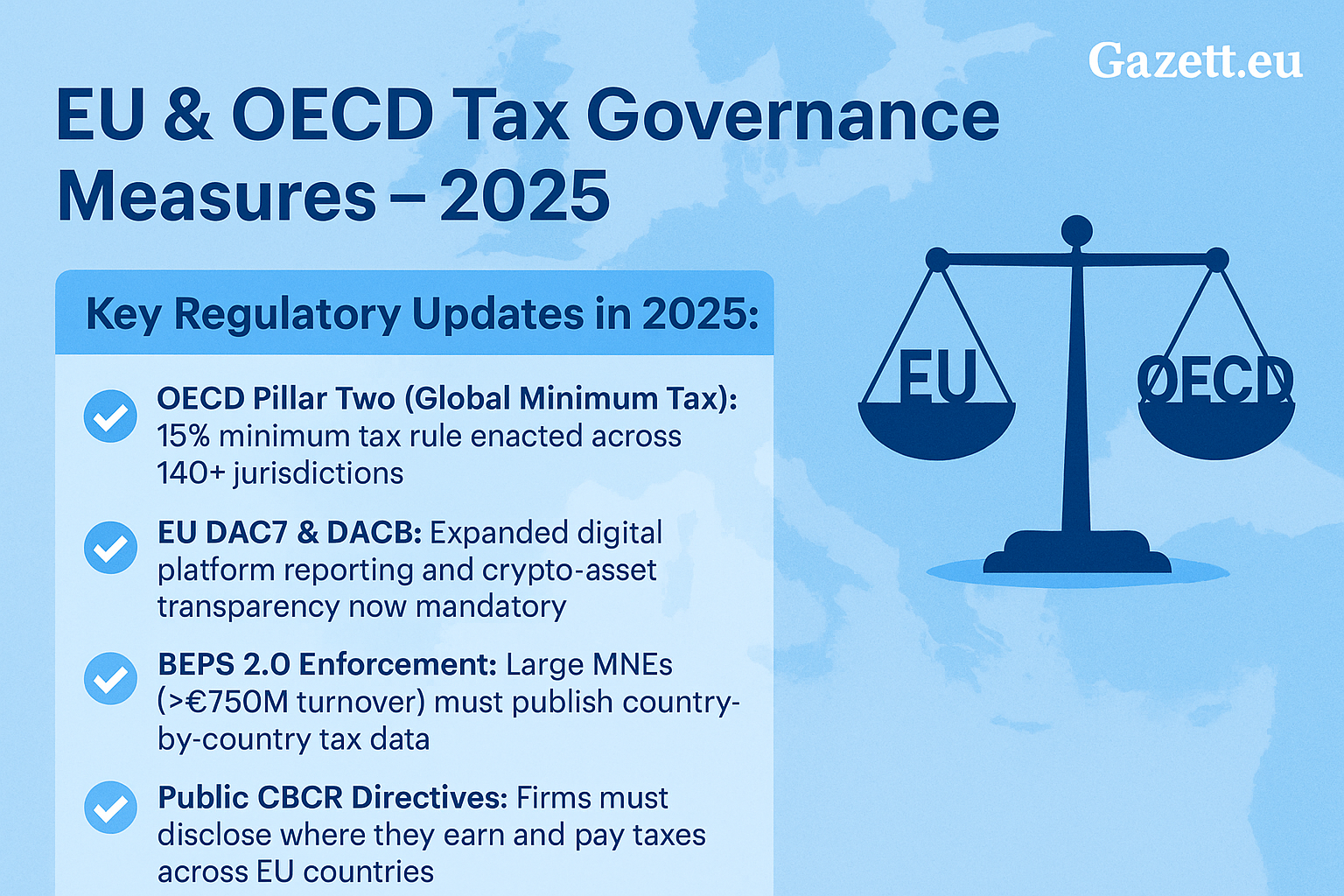
📷 Infographic: EU & OECD Tax Governance Measures – Gazett.eu, 2025
The following developments are particularly relevant for European tax jurisdictions:
Key Regulatory Updates in 2025:
- OECD Pillar Two (Global Minimum Tax): 15% minimum tax rule enacted across 140+ jurisdictions
- EU DAC7 & DAC8: Expanded digital platform reporting and crypto-asset transparency now mandatory
- BEPS 2.0 Enforcement: Large MNEs (>€750M turnover) must publish country-by-country tax data
- Public CBCR Directives: Firms must disclose where they earn and pay taxes across EU countries
These reforms do not eliminate tax competition — but they enforce a baseline. The leading jurisdictions in this article continue to offer advantages above this regulatory floor: via innovation regimes, bilateral treaties, and transparent, fast-track entity setups.
Summary Table + Strategic Takeaways for Investors 💡
Europe’s most competitive tax jurisdictions in 2025 offer more than just low rates — they provide policy predictability, innovation incentives, and global treaty access. Here’s a comparative snapshot of the top-ranked destinations in this report:
📷 Infographic: 2025 Comparison Matrix – Europe’s Top Tax Jurisdictions | Gazett.eu
| Country | Corporate Tax Rate | Personal Income Tax | Tax Treaties | Unique Advantage |
|---|---|---|---|---|
| 🇪🇪 Estonia | 20% (only on distributed profits) | Flat 20% | 60+ | Zero tax on reinvested profits |
| 🇭🇺 Hungary | Flat 9% | Flat 15% | 80+ | Lowest rate in EU |
| 🇮🇪 Ireland | 12.5% | Up to 40% | 70+ | R&D and IP incentives |
| 🇨🇭 Switzerland | 11.9%–20.5% | Varies by canton | 100+ | Cantonal customization |
| 🇱🇺 Luxembourg | Up to 24.94% | Up to 42% | 80+ | Holding & fund structure hub |
✅ Investor Tip: These countries aren’t competing on secrecy — they’re competing on efficiency, treaties, and reinvestment appeal. Choose based on your structure type: e-commerce? IP? private fund? digital services? Each jurisdiction fits a different model.
Sources: Tax Foundation Index 2024, PwC Tax Summaries, EU Taxation Portal